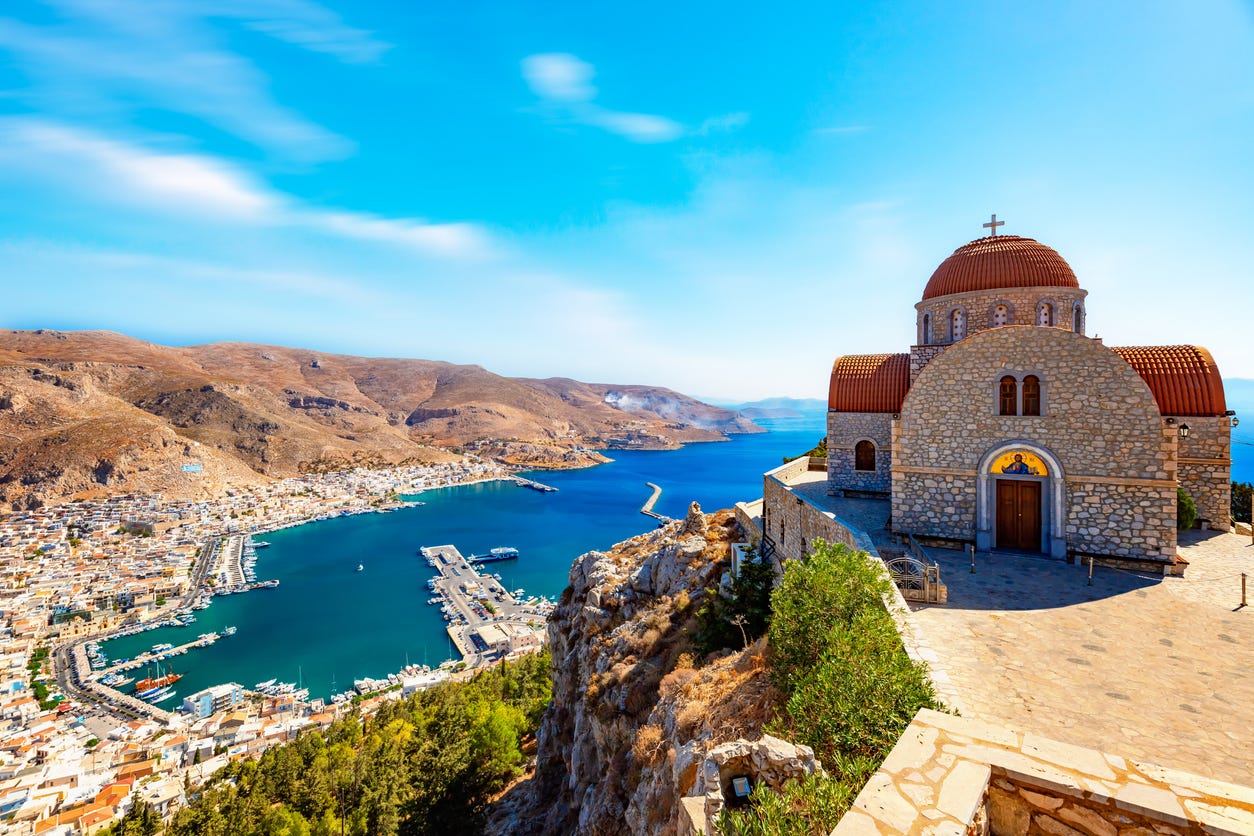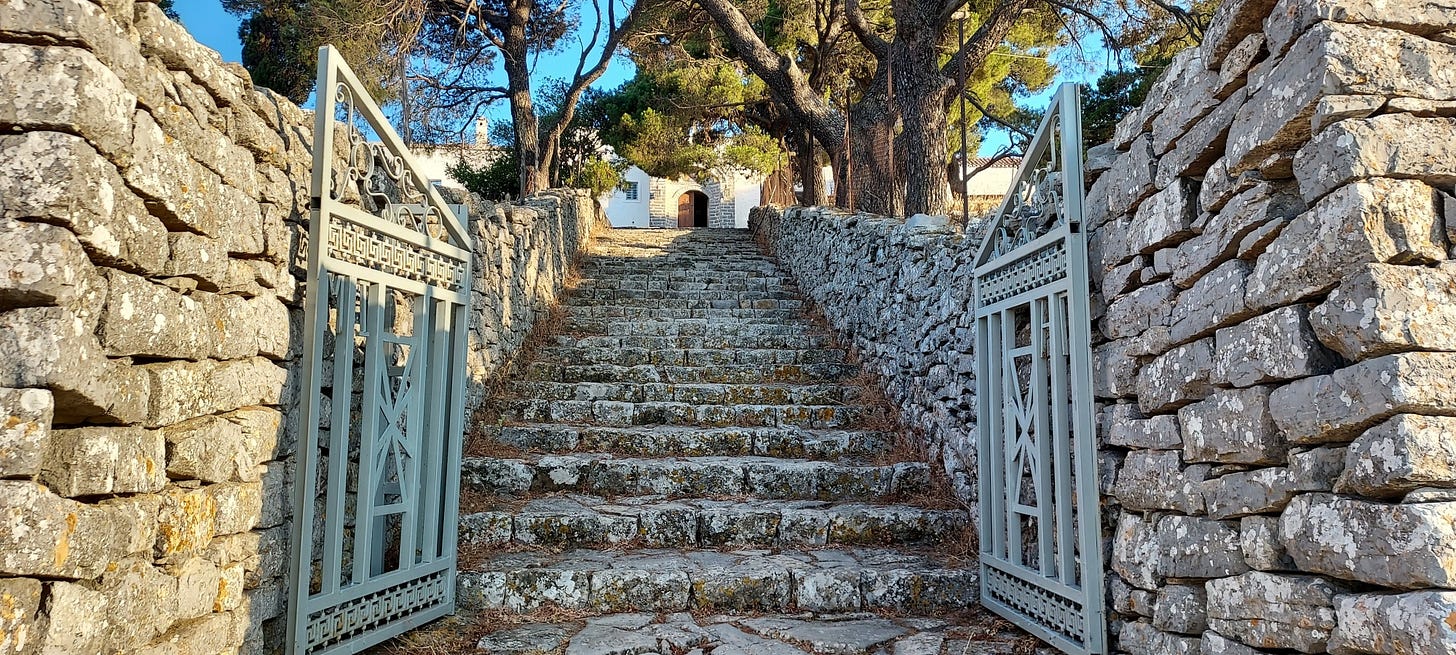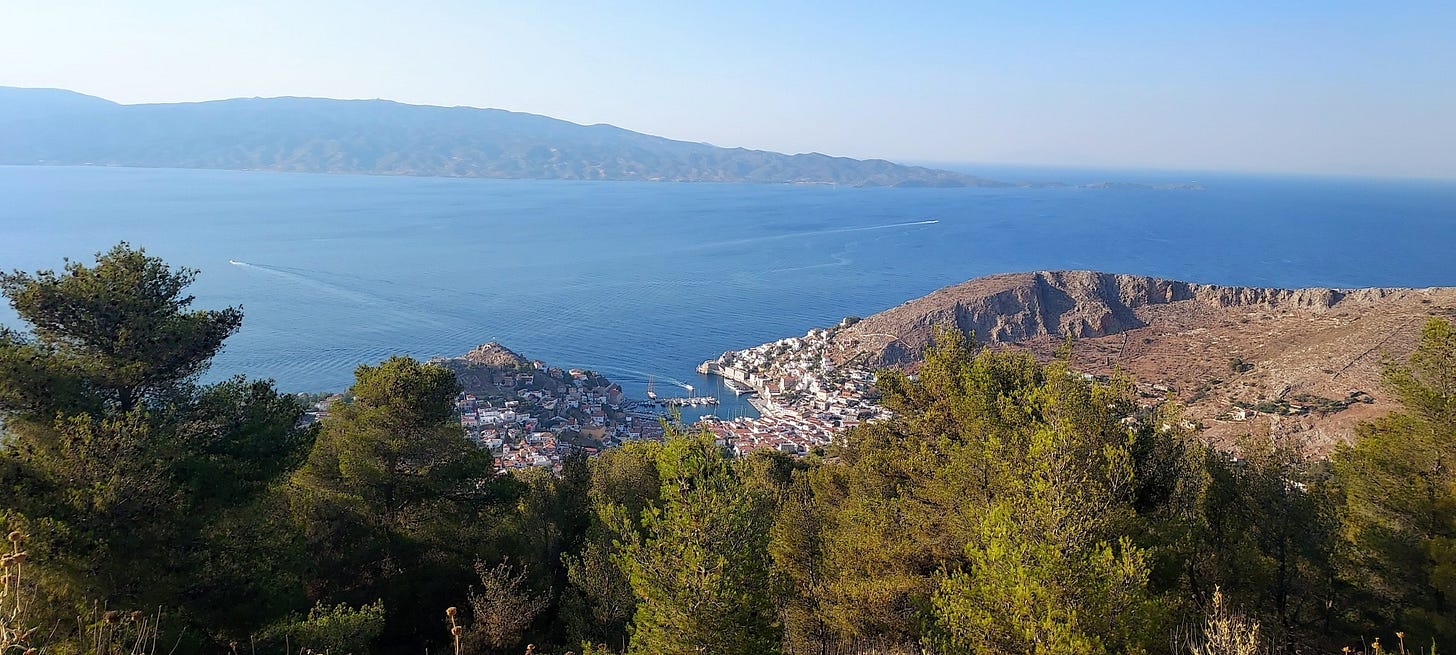A Greek Odyssey in Search of Solace and a Saint
A journey through hidden isles, mountaintop chapels, and Greece’s quiet spiritual heart.

Last summer, while ferrying into the Greek isle of Sifnos, I saw a familiar sight: a small, lonely white dot on a distant hilltop.
I’d seen this—a building, perhaps?—many times in my travels around the Greek Isles.
As I disembarked the ferry, I asked the friendly woman at the information kiosk what—or who—was on that mountaintop. I got the same answer I usually did: St. Elias.
Greeks don’t mean the actual St. Elias, of course. Those small white dots are often chapels, or monasteries—places of worship to commemorate the saint, whose feast day is celebrated all over Greece on July 20th. You might think of him as the Greek answer to St. Patrick. In the Bible, he’s known for conjuring rain during a drought. But his connection to Greece has pagan roots, too; he was often compared to Zeus, the Greek god of the sky, hence his elevated places of worship.
When I glimpsed that white dot on Sifnos, I’d been living on the island of Syros, capital of the Cyclades archipelago, for some 20 years. I was a frequent adventurer of these lesser-known Cyclades islands in the southeast, rather than the powerhouses of Mykonos, Paros, or Santorini.
These under-the-radar isles, I’ve found, provide better insight into daily Greek life than common tourist destinations. So I embarked on two adventures, to two different island groups, in search of a connection with St. Elias—and a deeper understanding of Greek culture. I invite you to come along…
In Hydra, an Ode to Leonard Cohen and an Empty Monastery
My first adventure: climbing the 1,500 feet required to reach the monastery of Prophet Elias on the island of Hydra. The monastery, located near the island’s highest peak of Mount Eros, was founded in 1813 by 13 Greek monks seeking a place of secluded worship—and secluded it is.
I ferried from my home on Syros to Athen’s port of Piraeus, and from there took a ninety-minute ferry to Hydra. For three nights I stayed in a cozy pension room in a private house, a mere thirty yards from the port’s busy waterfront cafes, bars, tavernas (pubs), and a towering clocktower.
St. Elias, the Greek answer to St. Patrick, is celebrated throughout the isles.
My stay was coincidentally an ode to another great man—if not a saint. Back in the ‘60s, Leonard Cohen used to hang out at this port alongside his literati friends. These days, the small, attractive port is inundated with affluent international and Greek tourists alike in summer, and costs reflect that. My obligatory morning cappuccino, served poli zesto (very hot) set me back nearly €6. Ouch!
Not to be distracted by this charming island’s tourist attractions (I was on a quest, after all) I made inquiries at the waterfront Roloi Cafe the following evening. The locals had warned me not to attempt the hike during the heat of the day, so it was an evening excursion—three hours before sunset.
While I’d located the monastery on my tourist map, I couldn’t figure out where to start the trek from. The friendly café host quickly gave me the necessary directions. It would be simple, he said, once I got started.
He was right… mostly. From Roloi Café, I headed up the adjoining laneway. This led me away from the waterfront up a gentle hill through the upper part of town for 150 feet. From there, I found my way to the main road that connected to a zig-zagging pedestrian path. The signs here pointed me to the mountainside, surrounded by idyllic conifer and pine trees.
As I climbed, I couldn’t help but wonder how those monks had managed to transport building materials up the mountain. Donkeys, surely—and perhaps some divine assistance to boot.
After an arduous 90-minute walk, the monastery buildings finally came into focus. It was certainly an uplifting feeling—as if a magnifying glass had been used to transform those tiny white dots into life-sized buildings.
I entered the grounds through an ornate stone gate at the head of the steep steps. There, I was greeted by a large barking Alsatian dog. There were no humans to be seen. But a caretaker must have been in residence somewhere, because once I pushed past the dog, it seemed to vanish. The monastery was eerily quiet, though it seemed to be in the midst of an extensive renovation.
The monastery hosts a rich, well-stocked library of valuable religious manuscripts. Fellow intrepid tourists, I advise you to ring ahead (+30 22980 52540) for their hours ahead of your own trek.
Though I couldn’t enter the monastery, I still felt the essence of this special place. The solitude and serenity of the grounds made me feel that I was in the celestial environs of the saint. The monastery grounds overlooked Hydra town and its port far below, plus several other islands out to the west. The light was a soft glow from the setting sun.
It was a relief to escape the summer hordes and ascend to an historic place of worship, especially one with such serene surroundings. Thank you, St. Elias.
In Kalymnos, a Fated Encounter With a Greek Congregation
My second adventure in honor of the great man was far more arduous. For this, I had headed east, to the Dodecanese islands near Turkey.
As my ferry cruised into the port of Kalymnos, I became acutely aware of the rugged mountain terrain and sheer limestone cliffs. Kalymnos is a mecca for mountaineers in more recent times, replacing its fame as a working island with a thriving sponge diving and fishing industry.
I settled into the picturesque village of Masouri, halfway up the west coast. This section of the island—with the villages of Mirties, Masouri, and Armeos—is the most picturesque and developed for tourists. These villages overlook the Aegean, with the main road directly above the sea. There’s plenty of affordable tourist accommodation here, plus tavernas and pedestrian-friendly footpaths. A regular bus service connects this tourist strip with the main town at the port.
Again I took a pension room on the waterfront. It looked out at the small adjoining island of Telendos, only a 15-minute boat ride away. (It’s a worthwhile sojourn, and the island offers numerous bars and tavernas for day-trippers from Kalymnos.)
But again I remained focused on the job at hand, which was to locate and visit the mountaintop chapel in honor of the prophet. The tourist map again showed its location at the center of the island, on the island’s highest peak of 2,000 feet.
A 20-minute bus ride took me to the central inland village of Chora, where my hike would begin. Again, I had difficulty finding the trailhead. But St. Elias intervened.
It was a Sunday, and I soon came upon a Greek Orthodox Church, with the characteristic blue-domed roof of the region. Its priest and congregation had spilled out onto the adjoining courtyard. I approached them for help, and in broken English I was directed by the kind priest to the starting point for my trek—only a couple hundred feet down the path.
I’d forgotten the wise advice I’d received in Hydra, and the congregation was incredulous that I would take the two-hour hike in the heat of the day. They advised me strongly against it, as best they could in Greek—but armed with my reliable wide-brim Akubra Aussie hat and a bottle of water, I pressed on. Being Aussie and tough go hand in hand—or so I thought.
A Two-Hour Endurance Test and a Locked Chapel

The hike took me up a narrow stone track through dry, barren countryside. Twice I almost faltered, but saw a reassuring—if dilapidated— sign with a painted arrow reading “Prophet Elias,” and so continued.
It was mid-afternoon and I was exhausted when I finally reached the whitewashed chapel and its adjoining buildings perched on the mountaintop. It wasn’t a large monastery complex set in comfortable grounds, as in Hydra, but a simple building with a small courtyard.
The spot offered a stunning 360-degree view of Kalymnos as well as neighboring islands. The two-hour endurance test, I decided, was well worth the effort.
After taking in the vista I headed to the chapel, but found it locked. Once again, I was deprived (vis à vis Hydra) of the ultimate experience of gaining access to his inner sanctum.
Perhaps the prophet was avoiding me… or just not in the habit of taking in unannounced random pilgrims like me.
I could understand why his followers sought such solace.
A thousand years of solitude could do that to any man, I suppose.
After a 30-minute rest I headed back down the mountain, disappointed.
But only fifteen minutes into my journey back down the mountain I spotted a tiny chapel built into the side of the mountain. It was set in a shallow cave, cut precariously into the underside of an overhanging rock.
I entered the tiny place of worship with extreme trepidation. Despite its sparse furnishings (just an altar and some chairs) all the usual religious accouterments were on offer, from candles to sacred religious icons of long-gone but never forgotten saints… including, at long last, Elias himself.
Such a peaceful place deserved contemplation. I couldn’t help but wonder if this was a small offering from Elias, in lieu of access to the chapel above.
Again, I found peace and tranquility, and I could now understand why the saint and his followers had sought such solace, with only nature and the sky as company. We were a long way from civilization and the distractions it brings.
Descending from the Home of Greek Gods
When I finished my trek back down the mountain, I stumbled, exhausted, into a small local taverna in the village of Chora. When I ordered a beer poli krios (very cold), the local patrons extricated themselves from their usual smoke-filled conversations. After explaining my expedition, they nodded in wonderment that this crazy Aussie had actually bothered to venture up the mountain on such a hot summer’s day.
One of the local patrons asked, tongue in cheek, if “the great man had been home” when I arrived at his mountaintop chapel. “Was he in good health after all of those centuries? “ another joked.
I’ve been to many of the Greek islands, but there is a common thread: the soul of Greece, emanating from its connection with the Greek gods. By searching for the Prophet Elias, I’d finally joined its long history.
— Gavin Woodward hails from Australia and has now lived in Greece for over 20 years, soaking up the country’s rich history.
Editor’s Note: This story first appeared in the pages of International Living magazine. Want more tales and expert insights like this? Click here to learn more.





Gavin — what a pilgrimage, in every sense of the word. I love how your journey wove mythology, faith, and human humor together — the monks, the dogs, the locals at the taverna teasing about Elias “being home.” You captured the soul of Greece beautifully: the endurance, the light, the quiet reverence between sea and sky. As fellow wanderers, we felt this one deeply. -Kelly
A lovely story. Are so many of the Greek isles connected via ferry? I've always imagined that unless one was located on a major island it would be difficult to move about, but I've never researched it.